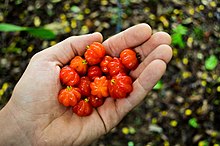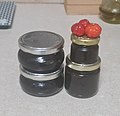| Surinam cherry | |
|---|---|
 | |
| Scientific classification | |
| Kingdom: | Plantae |
| Clade: | Tracheophytes |
| Clade: | Angiosperms |
| Clade: | Eudicots |
| Clade: | Rosids |
| Order: | Myrtales |
| Family: | Myrtaceae |
| Genus: | Eugenia |
| Species: | E. uniflora |
| Binomial name | |
| Eugenia uniflora | |
| Synonyms[2] | |
List
| |
| Nutritional value per 100 g (3.5 oz) | |
|---|---|
| Energy | 138 kJ (33 kcal) |
7.49 g | |
0.4 g | |
0.8 g | |
| Vitamins | Quantity %DV† |
| Vitamin A equiv. | 8% 75 μg |
| Thiamine (B1) | 3% 0.03 mg |
| Riboflavin (B2) | 3% 0.04 mg |
| Niacin (B3) | 2% 0.3 mg |
| Vitamin C | 29% 26.3 mg |
| Minerals | Quantity %DV† |
| Calcium | 1% 9 mg |
| Iron | 1% 0.2 mg |
| Magnesium | 3% 12 mg |
| Phosphorus | 1% 11 mg |
| Potassium | 3% 103 mg |
| Sodium | 0% 3 mg |
| †Percentages estimated using US recommendations for adults,[3] except for potassium, which is estimated based on expert recommendation from the National Academies.[4] | |
Eugenia uniflora, the pitanga,[5] Suriname cherry,[6] Brazilian cherry,[5] Cayenne cherry,[7] cerisier carré,[8] monkimonki kersie, ñangapirí,[9] or shimarucu[10] is a flowering plant in the family Myrtaceae, native to tropical South America’s east coast, ranging from Suriname, French Guiana to southern Brazil, as well as Uruguay and parts of Paraguay and Argentina.[8][11][12]It is often used in gardens as a hedge or screen. The tree was introduced to Bermuda for ornamental purposes but is now out of control and listed as an invasive species.[13]The tree has also been introduced to Florida.[14]
Description
Eugenia uniflora is a large shrub or small tree with a conical form, growing slowly to 8 metres (26 ft) high. When bruised, crushed, or cut, the leaves and branches have a spicy resinous fragrance, which can cause respiratory discomfort in susceptible individuals. The leaves are without stipules, ovate, glossy, and held in opposite pairs.[7] New leaves are bronze, copper, or coppery-pinkish in color, maturing to deep glossy green, up to 4 centimetres (1.6 in) long. During winter, the leaves turn red.
Flowers have four white petals and are borne on long slender stalks, with a conspicuous central cluster of white stamens ending in yellow anthers. Flowers develop into ribbed fruits 2 to 4 centimetres (0.79 to 1.57 in) long, starting as green, then ranging through orange, scarlet, and maroon as they ripen. Because fruit-eating birds distribute the seeds, they can become a weed in suitable tropical and sub-tropical habitats, displacing native flora.[7]
Uses
Culinary uses
The edible fruit is a botanical berry. The taste ranges from sweet to sour, depending on the cultivar and level of ripeness (the darker red to black range is quite sweet, while the green to orange range is strikingly tart). Its predominant food use is as a flavoring and base for jams and jellies.[15] The fruit is high in vitamin C and a source of provitamin A.
The leaves are also used for tea in certain parts of Uruguay.[citation needed]
Use as an insect repellent
The leaves are spread on some house floors in Brazil so that they exude a smell that repels flies when crushed underfoot.[citation needed]
Medical uses
Eugenia uniflora has several significant pharmacological properties.[16] Its essential oil is antihypertensive,[16][17] antidiabetic,[18] antitumor[19] and analgesic,[20] and it has shown antiviral and antifungal activity.[21] It has performed against microorganisms such as Trichomonas gallinae (in vitro),[22] Trypanosoma cruzi[23] and Leishmania amazonensis.[16][24]
Gallery
- flowers
- Eugenia uniflora fruits
- Eugenia uniflora
- Eugenia uniflora
- Eugenia uniflora
- Eugenia uniflora -young leaves
- With fruits on tree
- Pitanga jam
References
External links


- Purdue University New Crop Resource Online Program
- Eugenia uniflora in the Global Invasive Species Database Archived 2013-02-27 at the Wayback Machine
- Eugenia uniflora information from the Pacific Island Ecosystems at Risk project (PIER)
- Weed risk assessment for Eugenia uniflora for Hawaii/Pacific Retrieved 2010-06-20.
- Bermuda Department of Conservation Services, Invasive Species Page for Suriname Cherry.








